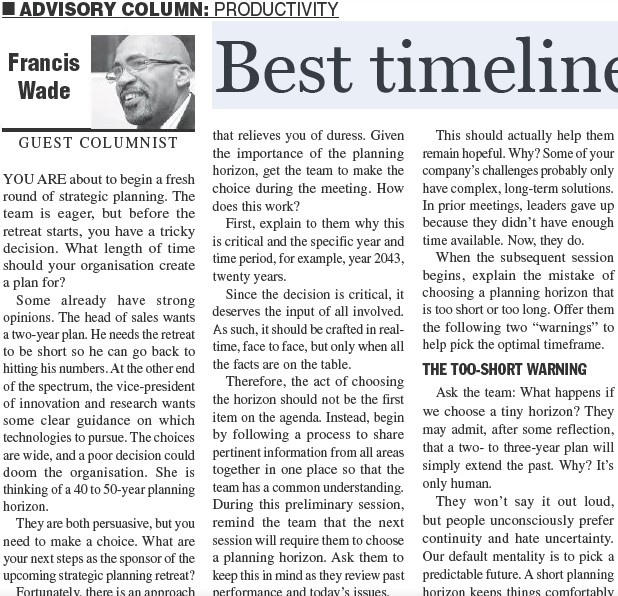You are about to begin a fresh round of strategic planning. The team is eager, but before the retreat starts, you have a tricky decision. What length of time should your organization create a plan for?
Some already have strong opinions. The head of sales wants a 2-year plan. He needs the retreat to be short so he can go back to hitting his numbers.
At the other end of the spectrum, the V.P. of innovation and research wants some clear guidance on which technologies to pursue. The choices are wide, and a poor decision could doom the organization. She is thinking of a 40-50 year planning horizon.
They are both persuasive, but you need to make a choice. What are your next steps as the sponsor of the upcoming strategic planning retreat?
- Punt the Decision
Fortunately, there is an approach that relieves you of duress. Given the importance of the planning horizon, get the team to make the choice during the meeting. How does this work?
First, explain to them why this is critical – the specific year and time elapsed (e.g., 2043, 20 years). It’s a critical one that deserves the input of all involved. As such, it should be crafted in real-time, face to face, but only when all the facts are on the table.
Therefore, the act of choosing the horizon should not be the first item on the agenda. Instead, begin by following a process to share pertinent information from all areas together in one place so that the team has a common understanding. During this preliminary session, remind the team that the next session will require them to choose a planning horizon. Ask them to keep this in mind as they review past performance and today’s issues.
This should actually help them remain hopeful. Why? Some of your company’s challenges probably only have complex, long-term solutions. In prior meetings, leaders gave up because they didn’t have enough time available. Now, they do.
When the subsequent session begins, explain the mistake of choosing a planning horizon which is too short or too long. Offer them the following two “warnings” to help pick the optimal timeframe.
- The Too-Short Warning
Ask the team, “What happens if we choose a tiny horizon?” They may admit (after some reflection) that a 2 to 3-year plan will simply extend the past. Why? It’s only human.
They won’t say it out aloud, but people unconsciously prefer continuity and hate uncertainty. Our default mentality is to pick a predictable future. A short planning horizon keeps things comfortably the same.
But what about the power of a transformation? You should also remind them that if they don’t use time as a deep resource, they won’t create a Jim Collins-like Big Hairy Audacious Goal (BHAG). Such objectives are meant to inspire and uplift. They give meaning and add resilience, especially to younger staff.
Also, with a short planning horizon, key problems which need time will remain unsolved. Plus, you’ll also be missing important trends. For example, a 5-year planning horizon blocks you from seeing developments which take 7 years to mature. By contrast, if your competitors consider a longer time frame, they might include the trend in their thinking to their advantage.
Finally, aggressive executives love short-time frames because they see it as a way to force staff to work harder, and achieve results sooner. The problem is that some projects (like pregnancy) can’t be rushed. Don’t pretend that magic is real, or you’ll see employees merely going through the motions, doing the minimum.
Why? At its heart, short-termism is a synonym for selfish leadership. “My current needs trump your future needs.” It’s as if the team is also saying, “Instead of making difficult decisions now, we will leave them for you young folk in the hope that you still have time.” It’s the very opposite of sustainable business thinking.
- The Too-Long Warning
Sometimes team members become true believers in long-term reasoning. They say “the more the merrier!” and call for a one-hundred year planning horizon. They may even cite examples of Asian organizations which do so.
However, you should take a look at your environment. Chances are, a planning horizon which is too long will mystify stakeholders who can’t relate. Instead of being inspired, they’ll become cynical.
Also, you might not have the resources or skills to plan too far out. Remember, whatever horizon you choose must be connected back to today.
Get your team to find consensus on the optimal time horizon in a healthy, real-time debate. It will set the stage for the success of your organization’s strategic plan.
Francis Wade is the author of Perfect Time-Based Productivity, a keynote speaker and a management consultant. To search his prior columns on productivity, strategy, engagement and business processes, send email to columns@fwconsulting.com.

